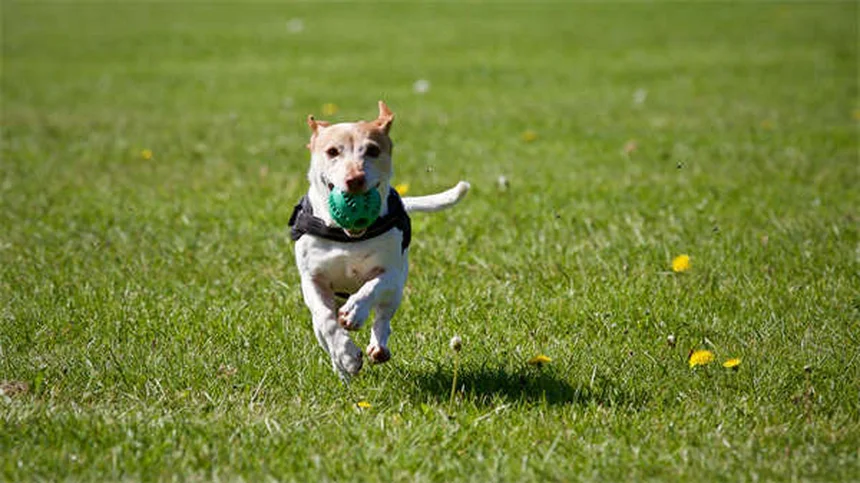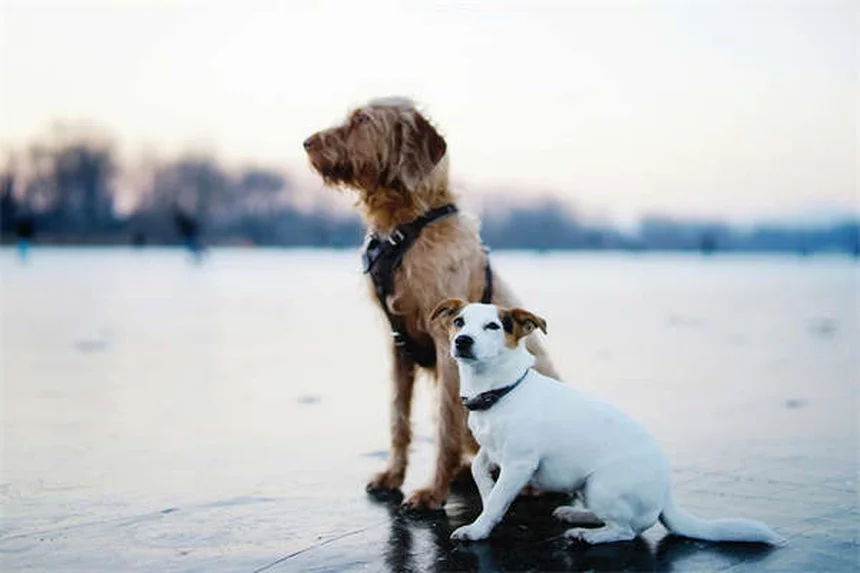Advertisement
How can you keep your dog safe during summer walks? The answer is simple: by being smart about timing, hydration, and paw protection. I've learned through years of dog ownership that summer walks require special precautions - your pup can't tell you when the pavement's too hot or when they're overheating. That's why I always test pavement temperatures with my hand before letting my dog walk on it, and never leave home without water for both of us.Summer heat poses real dangers for dogs - from burned paws to life-threatening heatstroke. But with proper planning, you can enjoy safe walks together. The key is understanding that dogs don't handle heat like humans do. They can't sweat through their skin and rely mainly on panting to cool down. That's why we need to be extra vigilant about their comfort and safety when temperatures rise.
E.g. :Can Benadryl Calm Dogs? Vet-Approved Answers & Better Solutions
- 1、Timing is Everything for Summer Walks
- 2、Hydration Station: Water Wisdom
- 3、Paw Protection Like a Pro
- 4、Shade Strategies That Work
- 5、Reading Your Dog's Signals
- 6、Special Considerations by Breed
- 7、Summer Safety Gear Must-Haves
- 8、When to Skip the Walk Altogether
- 9、Emergency Preparedness
- 10、Beyond the Basics: Advanced Summer Walk Strategies
- 11、Nutrition and Summer Walks
- 12、Mental Stimulation Alternatives
- 13、Community Resources for Hot Days
- 14、Traveling With Your Dog in Summer
- 15、Seasonal Allergies and Your Dog
- 16、Building a Summer-Ready First Aid Kit
- 17、FAQs
Timing is Everything for Summer Walks
Beat the Heat with Smart Scheduling
You know that feeling when you step outside at noon in July and immediately regret it? Your dog feels that ten times worse! Early morning and late evening walks aren't just more comfortable - they're safer for your pup's paws and overall health.
Here's a pro tip: if you must walk during daylight hours, test the pavement with your bare hand. Can't hold it there for 7 seconds? Then it's absolutely too hot for Fido's sensitive paws. I learned this the hard way when my golden retriever started doing an awkward "hot pavement dance" one afternoon. Now we stick to our 6 AM and 8 PM walking routine.
Why Midday Walks Are Risky
Between 10 AM and 4 PM, asphalt temperatures can reach a scorching 140°F - that's hot enough to fry an egg! Dogs don't wear shoes, so imagine walking barefoot on that surface. Ouch!
Check out these pavement temperature comparisons:
| Air Temperature | Asphalt Temperature | Safe for Paws? |
|---|---|---|
| 77°F | 125°F | No |
| 86°F | 135°F | Absolutely not |
| 75°F | 110°F | Borderline - test first |
Hydration Station: Water Wisdom
 Photos provided by pixabay
Photos provided by pixabay
Never Leave Home Without H2O
Would you go for a 3-mile hike without water? Of course not! So why would your dog? I always carry a collapsible silicone bowl and a water bottle specifically for my pup. It clips right to my walking belt - super convenient!
Here's a funny story: my neighbor's labrador once drank an entire bowl at the dog park, then immediately jumped in the water feature. Turns out he wasn't just being silly - dogs often combine cooling methods when they're really hot.
How Often Should You Offer Water?
Every 15-20 minutes is ideal, but watch for these signs your dog needs hydration now:
- Excessive panting (more than normal for the activity level)
- Thick, sticky saliva
- Looking back at you expectantly (that "water please" face)
Paw Protection Like a Pro
Booties Aren't Just Fashion
I used to think dog shoes were ridiculous until I saw how much happier my pup was wearing them on hot days. Quality matters here - look for breathable mesh tops with rugged soles. We tried the cheap ones first, and let's just say they didn't survive the first squirrel chase!
Don't want to deal with boots? Paw wax works wonders too. Apply it before walks to create a protective barrier. Bonus: it helps in winter too by preventing salt irritation.
 Photos provided by pixabay
Photos provided by pixabay
Never Leave Home Without H2O
Here's a simple trick: place the back of your hand on the pavement for 7 seconds. If it's uncomfortable for you, it's dangerous for your dog. This test has saved my dog's paws more times than I can count!
Remember: grass isn't always cooler either. On really hot days, even shaded grass can be uncomfortably warm. Always test first!
Shade Strategies That Work
Plan Your Route Like a Park Ranger
I've become a master at mapping shady walking routes. Here's my system:
- Scope out tree-lined streets in advance
- Note buildings that cast afternoon shadows
- Identify parks with covered picnic areas
Did you know dogs can get sunburned too? That's right - especially those with light-colored or thin coats. Shade helps prevent this while keeping them cooler.
What If There's No Shade?
Sometimes you're stuck walking in full sun. In these cases:
- Bring a portable umbrella (yes, they make hands-free dog walking ones!)
- Use a cooling vest soaked in water
- Take frequent breaks in any available shade
Reading Your Dog's Signals
 Photos provided by pixabay
Photos provided by pixabay
Never Leave Home Without H2O
You might wonder: how can I tell if my dog is in trouble? Look for these warning signs:
- Bright red gums (should normally be pink)
- Excessive drooling (more than their usual slobber)
- Stumbling or seeming disoriented
If you see these signs, stop immediately. Find shade, offer water, and wet their paws and belly with cool (not cold) water. I keep a small spray bottle in my walking pack for emergencies.
The Panting Myth Debunked
All dogs pant, right? So how do you know when it's dangerous? Here's the difference:
- Normal panting: tongue out, even breathing after exercise
- Dangerous panting: rapid, shallow breaths with wide eyes
When in doubt, err on the side of caution. It's better to cut a walk short than risk heatstroke.
Special Considerations by Breed
Short-Nosed Dogs Need Extra Care
Pugs, bulldogs, and other flat-faced breeds have a harder time cooling down. Their adorable smooshed faces actually make breathing less efficient. I learned this when my friend's pug needed emergency care after just 15 minutes in mild heat!
For these breeds:
- Keep walks under 10 minutes when it's above 80°F
- Always walk in early morning/late evening
- Consider indoor play instead on hot days
Thick-Coated Breeds Aren't Always Obvious
You'd think huskies would struggle most, but their double coats actually provide insulation. The real surprise? Black dogs! Their dark fur absorbs more heat. My neighbor's black lab needs twice as many water breaks as my yellow lab in the same conditions.
Summer Safety Gear Must-Haves
The Walking Kit I Swear By
After years of trial and error, here's what's always in my summer walking kit:
- Insulated water bottle (keeps water cool for hours)
- Collapsible bowl with carabiner clip
- Paw balm and portable first aid supplies
- Cooling bandana (soak in water before walks)
- High-visibility leash for early/late walks
This might seem like overkill, but trust me - when you're a mile from home and your dog starts overheating, you'll be glad you packed it all!
Tech Gadgets That Actually Help
Some high-tech solutions worth considering:
- Temperature-monitoring collars (alerts when your dog gets too hot)
- GPS trackers (in case they slip their leash)
- Portable misting fans (great for park outings)
I resisted tech at first, but the temperature collar gave me peace of mind during last year's heat wave.
When to Skip the Walk Altogether
Red Flag Weather Conditions
Some days are just too dangerous for walks. Skip outdoor exercise when:
- Heat index exceeds 90°F
- Air quality alerts are in effect
- Pavement is too hot for the 7-second test
Remember: a skipped walk won't ruin your dog's routine, but heatstroke could ruin their health.
Indoor Alternatives That Work
On no-walk days, try these indoor activities:
- Hide-and-seek with treats
- Puzzle toys (the ones where they work for kibble)
- Staircase fetch (if your dog is healthy enough)
- Training sessions (mental exercise tires them out too!)
My dog actually gets more excited for our "find the treat" game than regular walks now!
Emergency Preparedness
What to Do in a Heat Emergency
If your dog shows severe heatstroke symptoms:
- Move to shade or air conditioning immediately
- Offer small amounts of cool (not cold) water
- Wet their paws, belly, and ears with cool water
- Call your vet while transporting them
Never use ice water - the shock can make things worse. I keep an emergency card in my wallet with my vet's after-hours number.
Building Your First Aid Kit
Every dog owner should have:
- Vet's contact info (regular and emergency)
- Basic wound care supplies
- Digital thermometer (learn your dog's normal temp)
- Emergency blanket (for shock)
It takes one scare to realize how unprepared most of us are. Don't wait until it's too late!
Beyond the Basics: Advanced Summer Walk Strategies
Creating a Summer Walking Routine That Works
You might think walking your dog is just about grabbing the leash and going, but there's an art to it during summer months. I've developed a system that keeps my pup happy and healthy even during heat waves.
First, let's talk about pre-walk preparation. About 30 minutes before heading out, I give my dog some ice cubes to chew on. This helps lower their core temperature before we even step outside. Then I do the pavement test while they're enjoying their "pupsicle." Smart, right?
The Hidden Dangers of Humidity
Most people focus on temperature, but humidity is the silent killer for dogs. Did you know dogs can't sweat like we do? They rely on panting to cool down, and high humidity makes this process much less effective.
Here's a quick comparison of how humidity affects dogs versus humans:
| Humidity Level | Human Comfort | Dog Comfort |
|---|---|---|
| Below 40% | Comfortable | Ideal for dogs |
| 40-60% | Slightly uncomfortable | Monitor closely |
| Above 60% | Very uncomfortable | Danger zone |
Nutrition and Summer Walks
Pre-Walk Meals: Timing Matters
Ever feel sluggish after eating a big meal then exercising? Dogs experience this too! I learned this lesson when my golden retriever got sick after a walk following his breakfast.
Now I follow the 90-minute rule: no vigorous walks for at least 90 minutes after meals. For small breeds or dogs prone to bloat, I wait even longer - about 2 hours. This simple change made a world of difference in my dog's comfort during summer walks.
Hydration Through Food
Here's a trick most dog owners don't know about: you can boost hydration through food! Before summer walks, I add water to my dog's kibble or give him water-rich treats like cucumber slices or watermelon (seedless, of course).
These foods provide extra fluids and electrolytes naturally. Just avoid salty treats - they'll make your dog thirstier. My pup goes crazy for frozen watermelon cubes on hot days!
Mental Stimulation Alternatives
When Physical Exercise Isn't Possible
Some days it's just too hot to walk, but that doesn't mean your dog can't get stimulation. I've discovered that mental exercise can tire out a dog just as much as physical activity.
My favorite trick? The "muffin tin game." Take a muffin tin, put treats in some cups, cover all cups with tennis balls, and let your dog figure it out. The first time I tried this, my dog was mentally exhausted after 15 minutes!
Scent Work: The Indoor Alternative
Dogs experience the world through their noses, so why not use that to your advantage? Hide treats around the house and let your dog "hunt" for them. Start easy, then increase difficulty as they get better.
I was amazed at how quickly my dog picked this up. Now on scorching days, we do "scent trails" in the air-conditioned house instead of walks. He sleeps just as soundly afterward!
Community Resources for Hot Days
Indoor Dog Parks and Play Spaces
Did you know many cities now have indoor dog parks? These air-conditioned wonderlands are perfect for summer socialization when outdoor parks are too hot.
I found one near me that even has a small pool and agility equipment. The membership fee pays for itself in summer months when we can't use regular parks. Plus, my dog gets to make new friends in a safe, cool environment.
Dog-Friendly Stores and Malls
Many pet stores and even some malls welcome leashed dogs. On extremely hot days, I'll take my dog for a "shopping walk" where we browse the aisles together.
It's not the same as a park walk, but the air conditioning and new smells provide great stimulation. Just be sure to check store policies first - I always call ahead to confirm dogs are welcome.
Traveling With Your Dog in Summer
Car Safety for Summer Adventures
Planning a summer road trip with your pup? Here's something most people don't consider: even with AC running, the car can become dangerous quickly if you're stuck in traffic.
I always pack a car emergency kit that includes:
- Extra water (twice what I think I'll need)
- Cooling mats for the car seat
- Battery-operated fan
- Window shades
Finding Dog-Friendly Pit Stops
Before any summer trip, I map out rest stops with shaded pet areas. Some truck stops even have indoor pet relief areas - a lifesaver when it's 100°F outside!
Pro tip: many fast food drive-throughs will give you a cup of ice water for your dog if you ask. I discovered this when my dog was panting heavily during a long drive, and now it's part of our travel routine.
Seasonal Allergies and Your Dog
Summer Allergies You Might Not Notice
While we're worrying about heat, many dogs suffer from summer allergies too. The signs can be subtle - excessive paw licking, red eyes, or even just seeming more tired than usual.
After my dog started scratching constantly last summer, my vet recommended wiping his paws after every walk. Turns out he was allergic to some summer grasses! Now we do "paw baths" with a damp cloth when we come inside.
Air Quality and Your Dog's Health
Summer often means poor air quality from wildfires or pollution. Dogs are closer to the ground where ozone and other pollutants concentrate, making them especially vulnerable.
I check air quality apps before walks now. If it's code orange or worse, we skip the walk or keep it very short. My dog doesn't understand why, but his lungs thank me later!
Building a Summer-Ready First Aid Kit
Beyond the Basics: Must-Have Summer Additions
Every dog owner should have a first aid kit, but summer requires some special additions. Here's what I've added to mine after dealing with various summer emergencies:
- Electrolyte solution made for dogs
- Instant cold packs (the kind you snap to activate)
- Paw protection wax
- Dog-safe sunscreen (yes, dogs need it too!)
Last summer, the electrolyte solution saved us when my dog got overheated at the park. A little mixed with his water and he perked right up!
Knowing Your Dog's Normal Vital Signs
Here's a question: do you know your dog's normal temperature, pulse, and respiration rates? Most owners don't, but this info is crucial in an emergency.
I keep a card in my wallet with my dog's baseline stats. It only took one panicked vet visit to realize how helpful this is. Now I can tell the vet exactly how far off his normal readings are.
E.g. :10 Summer Dog Walking Tips | PetMD
FAQs
Q: How hot is too hot to walk my dog?
A: When the air temperature hits 77°F, pavement can reach a scorching 125°F - way too hot for your dog's paws! I use the 7-second test: if I can't comfortably keep my hand on the pavement for 7 seconds, it's unsafe for my pup. Between 10 AM and 4 PM is typically the danger zone, even on moderately warm days. That's why I always plan our walks for early morning or late evening when temperatures are cooler and surfaces have had time to cool down.
Q: What are the signs my dog is overheating?
A: Watch for excessive panting, bright red gums, stumbling, or thick drool - these are red flags your dog's in trouble. I learned this the hard way when my golden retriever started acting disoriented on a hot day. Now I know to look for these warning signs and act immediately by finding shade, offering water, and wetting their paws and belly with cool (not cold) water. Remember - dogs can't tell us when they're in distress, so we need to be their advocates.
Q: Do certain dog breeds need extra protection in heat?
A: Absolutely! Short-nosed breeds like pugs and bulldogs are especially vulnerable because they can't pant efficiently. My friend's pug needed emergency care after just 15 minutes in mild heat! Dogs with thick coats or dark fur also overheat faster. For these pups, I recommend shorter walks during cooler hours, plenty of water breaks, and considering indoor play instead when temperatures soar above 80°F.
Q: What should I pack for summer dog walks?
A: My summer walking kit always includes an insulated water bottle, collapsible bowl, paw balm, cooling bandana, and first aid supplies. After years of trial and error, I've found these essentials make all the difference in keeping my dog safe and comfortable. I also carry a small spray bottle for emergency cooling and a high-visibility leash for those early morning/late evening walks when visibility is low.
Q: Are there times I should skip the walk altogether?
A: Yes! When the heat index exceeds 90°F or there are air quality alerts, it's safer to stay indoors. On these days, I set up fun indoor activities like hide-and-seek with treats or puzzle toys to keep my dog mentally stimulated. Remember - a skipped walk won't harm your dog, but heatstroke could be life-threatening. When in doubt, err on the side of caution and find creative ways to exercise indoors.







